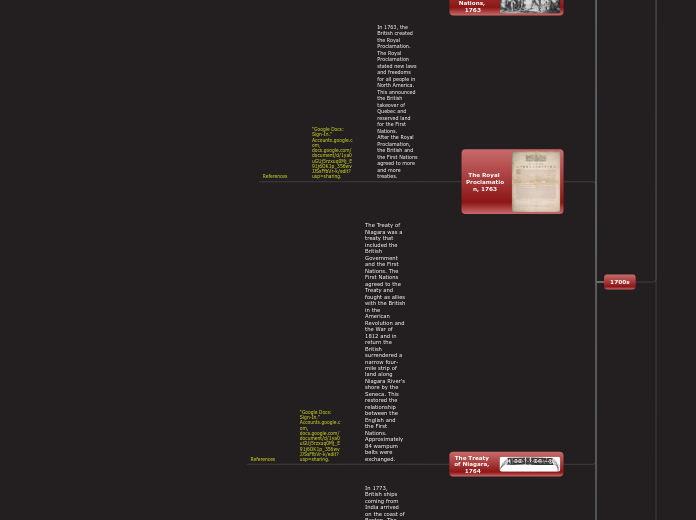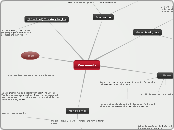The History of Canada
By Om Sawant
Learn more about how a small village on the banks of the Tiber River became the core of one of the most powerful ancient civilizations.
1800s
Political Unrest, 1830s
Impacts on Groups
Black
In 1833, Britain abolished slavery in Canada, but Black Canadians faced discrimination in Oro Township
Mary O'Brien, a white settler in Oro, witnessed the hostility Black people faced in Canada, including in schooling, housing, and employment.
Irish
Irish Catholics arrived in Canada in 1847, escaping a famine. Tensions arose with the Protestant population, leading to the opening of Ireland Park in Toronto in 2007, reflecting changing attitudes towards Irish immigrants.
First Nations
The British government believed First Nations populations needed conversion to Christianity and agricultural education
Settler Frances Stewart, arriving in Upper Canada in 1822, exchanged letters with her relatives.
In 1814, under Miles Macdonell's governorship, the Métis faced a food shortage and issued the Pemmican Proclamation, banning pemmican export and buffalo hunt. This led to the North West Company leaving the area, while Hudson's Bay Company claimed it.
The Pemmican Proclamation
On June 19, 1816, 61 Métis, led by Cuthbert Grant, attacked 25 Hudson's Bay Company employees and settlers from the Red River Settlement, resulting in 20 deaths.
The Battle of Seven Oaks
Daniel Tracey, an Irish immigrant, faced jail time and a cholera epidemic in Montréal, leading to tensions between Upper and Lower Canada during the 1830s. His death highlights the cholera epidemic and immigration boom.
Government Struggles in the 1830s
Lieutenant-Governor Sir Francis Bond Head sent troops to Upper Canada to defeat Lower Canada's rebels. Reformer Mackenzie staged a rebellion in Toronto, leading to British forces defeating them, and burning rebel homes and farms.
Upper Canada Rebellions
In November 1837, the Patriotes in Lower Canada prepared for rebellion after a riot between French Reformers and British Loyalists. British troops intervened, leading to uprisings and defeats, and the Patriotes fleeing to the US.
Lower Canada Rebellions
Post-War Settlements, 1815
After the War of 1812, First Nations peoples struggled due to land loss and economic growth. The Mississauga Nation in Upper Canada faced settlers and struggled. The lieutenant-governor, Jones, converted to Christianity and became a Methodist minister.
He helped the Mississauga adjust to Europeans, making Ojibwe a written language and translating Bibles into different languages.
Impacts on Settlement on First Nations Communities
The Industrial Revolution in the early 1800s caused a population serge, leading to an increase in poverty and overcrowding. Because of this, the British sent later immigrents to Canada to prevent this problem from escelating further. The British would send the immigrents from Britian to Canada using timber ships. Each journey took eight weeks and one in every twenty-eight people died at sea.
Immigration from Canada from Britain
Oro Township was a government-sponsored settlement for War of 1812 Veterans, including Coloured Corps. Despite dispersed land grants, Black soldiers were only allowed to settle together in one area. In 1831, white people were allowed to move elsewhere. The land started to be worth more and more money, leading to a lot of people to sell their grants. However, descendants of the first settlers remained in Oro for 130 years.
Oro Township
Black veterains from the War of 1812 received land grands for their contributions in war. However, they faced discrimination and only received 100 acres of land in 1821, half of other soldiers. Despite this, they were still able to establish successful settlement in Canada.
Black Settlements
Also, the British allowed the soldiers who fought in the Napolionic Wars to settle in Canada. They provided them with supplies, transportation, food and land; similar to what happened to the Loyalists. However, poor soil, distance from American attacks, and isolated roads led to soldiers drifting to towns and cities for work.
From Soldiers to Settlers
In 1815, the Treaty of Ghent was signed, officially ending the War of 1812 in a draw. This treaty did not change the border between the United States of America and the British. During the War of 1812, the British built new forts and renovated old forts for protection against the Americans.
Overview
Significant Battles during the War of 1812
The Americans aimed to invade Montréal and disrupt British supply ties in Upper Canada, but poor leadership and communication led to their overestimation of British forces, leading to their retreat.
The Battle of Châteauguay
York, the capital of Upper Canada, was strategically important for weapons storage and the construction of the HMS Sir Isaac Brock. In 1813, the US took over York. The British responded by attacking Washington D.C. and setting the White House on fire.
The Battle of York and the Burning of Washington, D.C.
The Americans invaded Niagara in 1812, aiming to cut off British access to Detroit. However, they were defeated by British troops and a reduced American militia, leading to a retreated American force.
The Battle of Queenston Heights
In 1812, the Americans attempted to invade Upper Canada from Detroit, a crucial location for British and First Nations allies. However, a small group led by Brock successfully attacked Hull's 2500 troops, solidifying alliances.
The Siege of Detriot
The War of 1812, 1812
The War of 1812 was a war between the United States of America and the British. The war spanned three years. It started in 1812 and ended in 1815. The war ended in a draw. Some of the significant battles that took place during the War of 1812 which the United States of America won include the Battle of Lake Erie, the Battle of York and the Battle of New Orleans. Some of the battles that the British won include the Siege of Detroit, the Battle of Châteauguay and the Burning of Washington, D.C.
https://docs.google.com/document/d/1LQzUjIN3dfWNz4FqHxIsoJSEWSHSOdyVPW6tsCAUgo4/edit?usp=sharing
Why Did the United States of America Declare War?, 1812
The United States of America declared war on the British because of numerous reasons. One of the reasons was that the British were dealing with the Napoleonic Wars in Europe and so the Americans thought that the British would be weaker than usual. Another reason why the United States of America declared war was because the British were using a military strategy called impressment, which the United States of America was very against. Additionally, the British had interference with the United States of America's trade.
https://docs.google.com/document/d/18Bptjjtc5nveEbQwc_ByyC0-NuUjbArUXscH31Ck1I0/edit?usp=sharing
1700s
The Treaty of Greenville, 1795
Fall of the Roman Republic and rise of the Roman Empire
In what year did Caesar declare himself 'imperator', therefore becoming the sole dictator of Rome? This is the year in which the Republic government came to end.
Type in the answer.
The Treaty of Greenville was a treaty signed between the USA and various First Nations groups including the Miami, the Northwest Indian Confederation, the Ojibwa, the Ottawa and more. The treaty made it so that the USA gained more control over what is modern-day Indiana, Ohio, Michigan and Illinois. This treaty came with many consequences. The First Nations were forced to relocate to Oklahoma, the British saw one of their enemies become more strong and there was more tension between the US and the First Nations.
“Google Docs: Sign-In.” Accounts.google.com, docs.google.com/document/d/10F2EqDK-yhgpmgEqVuI0Z4YoE3oxJPKI-7Di0l7LZr4/edit?usp=sharing. Accessed 21 Nov. 2023.
Loyalists Challanges in Aquiring New Land, 1783
With so many Loyalists moving into the area, food and housing shortages were an urgent issue. Unfortunately, the Black Loyalists were never the first to get necessary supplies, equipment, or even land—that is if they were lucky enough to receive any at all. Remarkably, only one-third of the Black Loyalists received land grants and those who did frequently found that their newfound territory was unsuitable for farming.
https://docs.google.com/document/d/1BAHg13Wuc8SOztNL8ksAV8m_zM79n2Gn0tbWG19nMBY/edit?usp=sharing
Migration of Loyalists, 1776
During the mid-late 1700s, many British Loyalists, who lived in New England, immigrated to British North America. Some pull factors included the mass amounts of land available and Land Grants, which allowed over 8000 Loyalists to settle in British North America. Some push factors included the ongoing war between the Patriots and the British and keeping families safe.
What major event took place in 60 B.C.?
Type in the answer.
“Google Docs: Sign-In.” Accounts.google.com, docs.google.com/document/d/120YJ7AD11wzceo_7-aqaWms8WPERtUQCEEnhSkL_jNc/edit?usp=sharing. Accessed 21 Nov. 2023.
The American Revolution, 1755
After the Seven Years' War, tensions between British colonists and the British government escalated. The British government began charging colonists taxes on goods like sugar and stamps, leading to protests. Colonists felt the government was making decisions without their input and refused to obey laws without their input. Their motto became "no taxation without representation."
https://drive.google.com/file/d/1RRMZ-zWjjS3_x_zwn9qCxbgkw7a_r0xV/view
The Boston Tea Party, 1773
In 1773, British ships coming from India arrived on the coast of Boston. The ships contained hundreds of chests of tea. Indigenous rebellions disguised themselves as Patriots hijacked the ship and dumped all of the tea into the water. In total, 342 chests of tea were dumped. This event signified that the Indigenous are not going to back down or remain as subjects to the Patriots. This sparked a series of events that eventually led to the American Revolution. This event became known as the Boston Tea Party.
https://orbit.texthelp.com/?file=https://drive.google.com/uc?id=1RRMZ-zWjjS3_x_zwn9qCxbgkw7a_r0xV&export=download&filename=Attachment:%20PDF:%20Ch-4%20Mass%20Migration%20of%20Loyalists.pdf&ClassroomRetUrl=https%3A%2F%2Fclassroom.google.com%2Fu%2F0%2Fc%2FNjIwOTM4MjkwNjk4%2Fm%2FNjM4NTAyOTk0MjY1%2Fdetails
The Treaty of Niagara, 1764
First Roman emperor
Around what year did Augustus became the first Roman emperor?
Type in the answer.
The Treaty of Niagara was a treaty that included the British Government and the First Nations. The First Nations agreed to the Treaty and fought as allies with the British in the American Revolution and the War of 1812 and in return the British surrendered a narrow four-mile strip of land along Niagara River's shore by the Seneca. This restored the relationship between the English and the First Nations. Approximately 84 wampum belts were exchanged.
“Google Docs: Sign-In.” Accounts.google.com, docs.google.com/document/d/1ya0uGUj5rzxuq0Mj_E91j6OK1p_356wvJJSsFfbVr-k/edit?usp=sharing.
The Royal Proclamation, 1763
In 1763, the British created the Royal Proclamation. The Royal Proclamation stated new laws and freedoms for all people in North America. This announced the British takeover of Quebec and reserved land for the First Nations.
After the Royal Proclamation, the British and the First Nations agreed to more and more treaties.
What major event took place in 43 B.C., in the year after Caesar's assassination?
Type in the answer.
“Google Docs: Sign-In.” Accounts.google.com, docs.google.com/document/d/1ya0uGUj5rzxuq0Mj_E91j6OK1p_356wvJJSsFfbVr-k/edit?usp=sharing.
The Seven Years' War Impacts on First Nations, 1763
Third punic war
In what year did this war take place, leaving Carthage completely destroyed? Type in the answer.
The British started to move more and more soldiers, settlers and officials to Frist Nations territory. The First Nations were not okay with this so they started to attack the British more and more. These actions eventually lead to the Treaty of Niagara.
The Seven Years' War, 1763
The Seven Years' War or the French and Indian War was a war that involved the French, British and various other nations during the mid-18th century. The war resulted in the French giving up most of their territory in North America to the British and the French stopped trading with the First Nations.
What major event took place between 218 - 201 B.C.?
Type in the answer.
“Google Docs: Sign-In.” Accounts.google.com, docs.google.com/document/d/1ya0uGUj5rzxuq0Mj_E91j6OK1p_356wvJJSsFfbVr-k/edit?usp=sharing. Accessed 21 Nov. 2023.
The Acadian Expulsion, 1755
In 1755, the Acadians refused to stay loyal to the British crown, therefore the British ordered the expulsion of the Acadians. Over 10,000 Acadians were shipped to all over the world. Around one-third of the Acadians died at sea. The British used the Acadian land for settlers to farm. The Acadians were later allowed permission to go back to Acadia, but there was no reason to as the British had already destroyed their homes and farms.
“Google Docs: Sign-In.” Accounts.google.com, docs.google.com/document/d/1dPPr0fX6jBerzsSITomKOMOGKMiSdb1MmKvn-fHuctw/edit?usp=sharing. Accessed 21 Nov. 2023.
The Fur Trade
In what year did the Gauls attack Rome?
Type in the answer.
The fur trade was a 300 year trading alliance between the First Nations and the French and British. The conditions of the fur trade was so that the British would receive fur from animals such as bears, polar bears, beavers, etc. They would use the fur to give them warmth in the winter. The First Nations would receive metal pots and tools used for hunting and cooking.
“Google Docs: Sign-In.” Google.com, 2019, docs.google.com/document/d/1BYy1lswEImwgs-t384LV5qY_6Oqenf0-gj3hqULNIig/edit?usp=drive_link. Accessed 21 Nov. 2023.
The Treaty of Portsmouth, 1713
The Treaty of Portsmouth was signed between the British and the Wabanaki Confederacy. This Treaty meant that the British would stop building on Wabanaki territory and that the Wabanaki would stop attacking the British. This treaty was broken shortly after it was signed by the British as they started building on Wabanaki territory.
What major event took place in 509 B.C.?
Type in the answer.
“Google Docs: Sign-In.” Accounts.google.com, docs.google.com/document/d/1o1WSD60LaCnFkUm5oMvvWoe7LdvpphuRQWxb1TAAIe0/edit?usp=sharing. Accessed 21 Nov. 2023.
The Treaty of Utrecht, 1713
Around what year was Rome founded? Type in the answer.
The Tready of Utrecht was an agreement between the British and the French in the Dutch city of Utrecht. It resulted in France loosing a lot of it's land including Acadia. This affected the French-speaking Acadians as they had to adapt to an English environment. This treaty came as a result of the Spainish Succession.
“Google Docs: Sign-In.” Accounts.google.com, docs.google.com/document/d/1aX2Mc1M0j7adYXKHWJPaVRFHVGVQO5XYUyTtGLAVryo/edit?usp=sharing. Accessed 21 Nov. 2023.
The Spainish Succession, 1701
Spainish Succession was an event which started when the king of Spain King Charles II died while not having any kids, temporarity ending Spanish royality. During this time, England, Scottland and Wales united while fighting the French in a war.
https://study.com/learn/lesson/war-spanish-succession-overview-history.html#:~:text=The%20War%20of%20Spanish%20Succession%20(1701%2D1714)%20was%20a,claims%20to%20the%20Spanish%20Empire.
Pre 1700s
Early 1600s
By the early 1600s, the French and the British expanded their claims in North America by establishing permanent settlements and exploring and trading with the Indigenous. During this time, the French followed a seigneurial system which helped expand France's presence in North America. Most of the settlements originated in the east. As the years progressed, they would expand more and more west.
Europeans, 1500s
The European explorers from British and France started to build early settlements in North America. They would also trade with the Indigenous people, especially with fur. They would usually send the goods that they received from the Indigenous peoples back to Europe. The Indigenous would also help the Europeans to adapt to the harsh Canadian winters.
Pre Europeans, 1497
Before Europeans came, the Indigenous people of Canada already had an established way of life, their languages, traditions, cultures, government and beliefs. The various tribes traded and lived with each other with peace and friendship. Some Indigenous groups hunted, some groups fished and some groups farmed for food.
https://orbit.texthelp.com/?file=https://drive.google.com/uc?id=1y4C_cTbWPiaI7eMXmMSx-r8blnajvIoK&export=download&filename=Attachment:%20PDF:%20Who%20Wanted%20The%20Land,%20and%20Why.pdf&ClassroomRetUrl=https%3A%2F%2Fclassroom.google.com%2Fu%2F0%2Fc%2FNjIwOTM4MjkwNjk4%2Fm%2FNjIyMjg1Mzc4NzY2%2Fdetails
References









